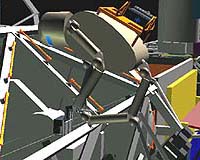| . |  |
. |
 Robots To Lend A Hand To ISS Crews
Robots To Lend A Hand To ISS CrewsHouston - June 11, 2000 - A robotic system aimed at giving spacewalking astronauts a hand is being refined at NASA's Johnson Space Center. A mechanical hand very much like a human hand offers remarkable abilities to operate the same tools used by people in spacesuits. The hand, in combination with an attached arm, is capable of actions as delicate as lifting small objects with tweezers. It is powerful enough to lift a 21-pound weight on the Earth's surface -- giving it considerable capabilities in a zero-G environment. Two of the hands will be used with the Robonaut system, which also includes two arms and swiveling head with cameras inside. The hand and the rest of the system are likely to find a range of applications on Earth. Among them are work in hazardous environments like some found in nuclear power plants and petroleum refineries. Makers of prosthetics also have expressed interest. Designers have worked hard to make the hand function like a human's. Through the cooperation of local medical schools, they were able to dissect human hands to improve their understanding of how they work. Chris S. Lovchik and M.A. "Ron" Diftler worked together on development of the hand, wrist and forearm. Lovchik, who works in Johnson Space Center's Robotics Technology Branch, did the hand design and forearm layout. Diftler, with Lockheed Martin's Automation and Robotics Department in Houston, worked on the wrist and forearm packaging. From the project's beginning about three years ago, Lovchik and Diftler's objective has been to reproduce in a machine some of the capabilities of a spacewalking astronaut, perhaps on the International Space Station. They decided the best approach was to make the robotic hands and arms like those of a human. Hand rails, foot restraints, tools and other support for space-walking astronauts are built into the station or sent up for the astronaut's use. The challenge was to develop a robot that could make use of them. "The world we've created is a product of our (human) form," Lovchik said. Alternatives were to design special tools, targets and other things for a robot, "or design a robot to function in our world. The hand is a critical element." Such a hand also has advantages for operators, who can use years of experience with their own hands in controlling the machine. The current model of the hand has 12 individual, controlled motions, or degrees of freedom. "You can think of it as divided into two sections," Lovchik said. "The first two fingers and the thumb make up the dexterous work side." They have three degrees of freedom -- they can open and close as well as spread apart, essentially like human fingers. The remaining two fingers only open and close -- they are used for grasping. The palm can "cup" to help grasp tools. "Some simplifications and compromises had to be made to create the hand." Lovchik said. It had to be functional enough to work with a variety of tools and other devices. It had to be rugged enough to survive the space environment. It had to be extremely compact, much like a human hand, wrist and arm. To meet all the criteria some motions of the human hand were not replicated. But designers always focused on retaining maximum flexibility. The hand and forearm weigh about six pounds. In the 8-inch forearm are 14 electric motors, 13 circuit boards, 12 five-element drive trains for the fingers, two two-element drives for the wrist, 42 base-level sensors which provide information on the position and velocity of each actuator. Tactile sensors, which will allow the hand operator a degree of feeling, will be added soon. Developers believe that as the hand evolves, other applications will emerge. The hand and the robot, together with a human operator some distance away, may eventually have the capability to do almost anything a human could do. That includes adapting to a situation that might not be fully understood before the robot is committed, Lovchik said. "You can give it a tool box and send it out there."
ROBOSPACE
|
| |||||||||
| The content herein, unless otherwise known to be public domain, are Copyright 1995-2016 - Space Media Network. All websites are published in Australia and are solely subject to Australian law and governed by Fair Use principals for news reporting and research purposes. AFP, UPI and IANS news wire stories are copyright Agence France-Presse, United Press International and Indo-Asia News Service. ESA news reports are copyright European Space Agency. All NASA sourced material is public domain. Additional copyrights may apply in whole or part to other bona fide parties. Advertising does not imply endorsement, agreement or approval of any opinions, statements or information provided by Space Media Network on any Web page published or hosted by Space Media Network. Privacy Statement All images and articles appearing on Space Media Network have been edited or digitally altered in some way. Any requests to remove copyright material will be acted upon in a timely and appropriate manner. Any attempt to extort money from Space Media Network will be ignored and reported to Australian Law Enforcement Agencies as a potential case of financial fraud involving the use of a telephonic carriage device or postal service. |